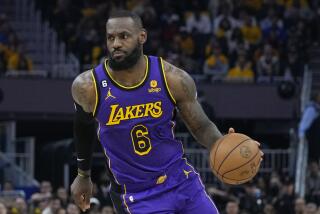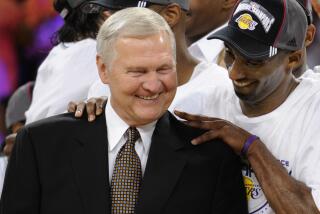Something in the Air
- Share via
At 79, with a few homes in quiet places and an old Cadillac that runs like new and not much more to gain than another NBA championship ring, which would be, oh, his ninth, Tex Winter returned to the Lakers, to Phil Jackson’s psyche, for one more season.
They cut his workload and his salary, and he won’t sit beside Jackson on the bench anymore, leaving others to cry out over the ball-palming, hand-checking point guards of the new NBA.
But by the time he is done, and he’s pretty sure this is it, Winter will have coached 55 seasons of basketball in NCAA Division I or the NBA. That’s 55 seasons of the triangle offense, and 55 seasons of players who could and couldn’t play it, often enough on the same night.
He mulled leaving at 54, leaving the grind to the others, letting them cope with the “new” zone defenses, letting them teach his offense to the eager and the flat, and leaving them with the boxes of books beneath his desk in El Segundo, all titled the same, “The Triple-Post Offense (Sideline Triangle),” by Fred “Tex” Winter.
It went out of print in 1968, six years after it was written. Some years later, his son, Brian, republished it. Now Winter gives them away, often with inscriptions.
After all these years, born from systems run 60 years ago by Sam Berry at USC and Pete Newell at Cal, Winter’s triangle held for its creator one final curiosity. Sitting recently in a coffee shop on Sepulveda Boulevard, not a mile from the Laker training facility, Winter said he had to be there when it worked, one last time.
“I wanted to experience NBA ball with any defense allowed, to see how my theories, my principles , held up,” he said, and then chuckled. “Well, they’d be theories to a lot of people. They’re principles to me. I preach them that way, and that’s the way I coach them.”
Weary of the game’s gradual slide toward isolation offense, with mismatches being played into one-on-one games while eight of the 10 players served as the gallery, NBA scholars established four new rules.
* The league’s rules against zone defenses are abolished.
* Players on defense may not be in the lane for more than three seconds unless closely guarding an offensive player.
* Offenses have eight seconds to get the ball to midcourt.
* More contact on defense will be allowed, as long as the progress of the player on offense is not impeded.
The reaction was, and is, mixed. The veterans of the game--Jerry West, Mitch Kupchak and Jackson among them--generally approve. Generation Z--those who might forever lose their isolated moments on the wing, except for some overmatched hump just begging to be humiliated--generally believes this is the worst thing to come along since FICA.
For the Lakers who supported them, the new rules might have been about the good of the game. For almost everybody else, including Shaquille O’Neal, it was about Shaquille O’Neal.
He emerged from a meeting with referees during camp and said, “The rules stink worse than I thought they did. They’re allowing high-priced players to be lazy on defense.” And then he threatened, again, to retire.
The rules allow opposing teams to defend against O’Neal from front and back, effectively denying him the ball and a lane to the basket, which is what O’Neal expects. He assumes there are others who will get the same treatment, that Allen Iverson, Tracy McGrady, Vince Carter and, maybe, Michael Jordan will be double-teamed away from the ball, reducing the game to low scores and no-names.
For a time, it appears, he might be right. While coaches seek a comfortable mix of zone and man-to-man defenses, a reasonable strategy against the Lakers would seem to allow, say, Rick Fox, a 44.4% shooter last season, to shoot, if the alternative is to play straight up on O’Neal, a 57.7% shooter.
It is, in fact, the strategy many teams employed last season against O’Neal, as referees failed to recognize it. When the New York Knicks beat the Lakers on April 1, they consistently, and improperly, zoned O’Neal. Kobe Bryant hardly played, and O’Neal scored 31 points, but the Lakers were 79-78 losers.
“If you play the Lakers, you put a guy behind Shaq and in front of Shaq,” Knick assistant Tom Thibodeau said. “You make them move it to the weak side. On some nights it’ll be good, some nights it’ll be bad. And as usual, if they’re making threes, you’re dead.”
O’Neal hates that kind of basketball, and his opinion remains unchanged even after several long conversations with Winter. Eight passes and a jump shot? You kidding?
“When I used to cut grass and go buy a ticket to watch the Spurs play the Bulls, I didn’t really care about the game,” O’Neal said. “I wanted to see Jordan dunk. I wanted to see David Robinson dunk.... I didn’t pay to watch Alvin Robertson shoot jumpers, or Johnny Moore shoot jumpers. I didn’t care about that. I wanted to see David dunk. I wanted to see Willie Anderson dunk. And I wanted to see Jordan dunk. That’s what people want to see.”
In the coffee shop, over chili, Winter thumped the table with his forefinger.
“The people who are going to remain dominant, the All-Star aspect of the NBA, the individual stars, are going to be the same people,” he said. “They’re just better basketball players. They have better instincts. They read defenses better. They can shoot the ball better. They’re quicker. More physical. Who does that describe?”
Winter does not believe any zone--with players defending an area in relation to the ball, rather than an opponent--can become a staple in the NBA, where players shoot, pass and think so well, but he said his system might actually benefit O’Neal against a zone.
“He might even gain points,” Winter said. “One thing he’s going to find, if they’re playing a true zone, and if they don’t do a good job of screening him out, he’s going to get an awful lot of second and third shots, putbacks, easier than he would if somebody was right there with him.”
The theme of the season could be weak-side scoring, whether that’s O’Neal bulling through the lane against two slabs of opponents, finding his place on the opposite block and waiting for the ball to swing around, or Bryant setting up outside, or flying to the rim. Winter also expects the Lakers to run more, another zone-busting tenet, more likely after an off-season in which Kupchak deftly replaced some heavy legs with fresh ones.
Coaches, of course, are having a hard time working up sympathy for O’Neal, a monster in the Lakers’ successive championship drives, when he regularly overpowered double-and triple-teams anyway.
“Shaq is still going to score,” Washington Wizard Coach Doug Collins said. “He’s big and he’s powerful and he’s strong. Phil Jackson is a magnificent coach and in their system they get all kinds of movement. Shaq’s going to get his points.
“The guys it might be tougher on are guys like Allen Iverson where, if you use a box-and-one-type of defense, where you can put a chaser on him
If there is a benefit to the lingering pain in O’Neal’s troublesome toe--he is still rehabbing from summer surgery--it is that his absence in exhibition games allowed opponents no early experimentation on defense. The Lakers have run Samaki Walker and others at center, and might have to continue for a while into the regular season.
“A great player has never been defeated by a rules change,” Golden State Warrior Coach Dave Cowens said. “Great players are great players, no matter the rules. And, with the team they have, nobody can afford to put three men on him. In fact, it may become an advantage for Shaq. He has to understand this rule change is not about him. It’s about ball movement. It’s about action.”
Since Jackson and Winter arrived in Los Angeles with their triangle two championships ago, the Laker emphasis has been on the system, even though O’Neal and Bryant are two of the most talented one-on-one players in the history of the game. They’ll run their pick-and-roll, or Bryant will isolate himself for a shot near the end of a possession, or they’ll feature O’Neal against an inferior defender. But the triangle is ball and player movement, no matter the defense, and while most teams were in camp learning motion on offense and consistent spacing, the Lakers already had it.
“If they want to play us like that, if a guy wants to sit back and wait for me to drive to the basket, then I’ll just pick them apart,” Bryant said. “I’ll hit my teammates for shots. If they want to collapse on Shaquille, then we have our big man step up to the free-throw line and he has to make those shots.
“Whatever the defense wants to do, I’m all for it. Really. If they want to double, I think we proved last year we’re more than capable of adjusting our strategy.”
In the meantime, Winter is teaching again, for one final season. He will be 80 in February, and he is expected to receive greater consideration for the Hall of Fame, a good place for basketball teachers and innovators.
Soon, his triangle offense will be someone else’s to mind, maybe Jackson’s, after this one last trial.
“Actually,” Winter said, “the players have taught me a lot more than I’ve taught them, with the things I see them do in the context of the offense. It’s evolved over the years, and will again.”
More to Read
All things Lakers, all the time.
Get all the Lakers news you need in Dan Woike's weekly newsletter.
You may occasionally receive promotional content from the Los Angeles Times.






